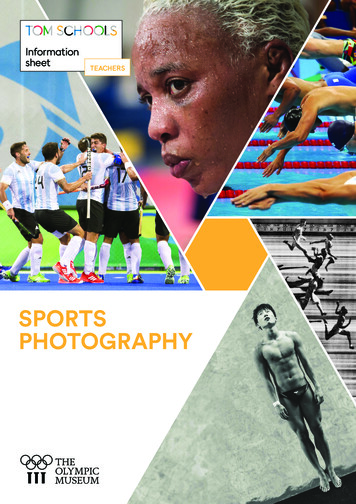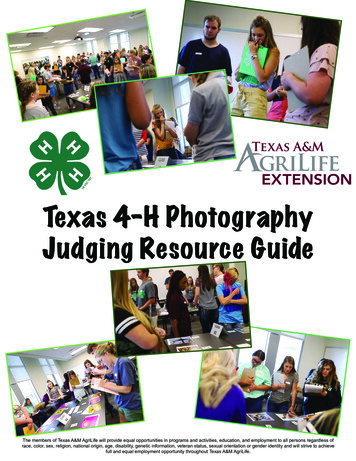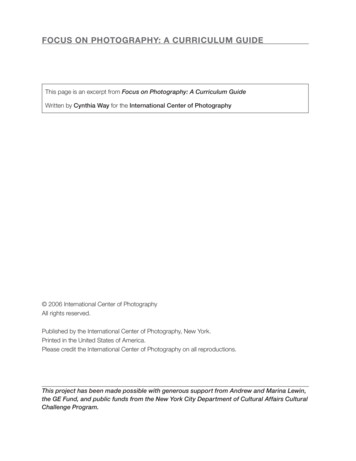
Transcription
PHOTOGRAPHY
“ I would willingly exchange every singlepainting of Christ for one snapshot”George Bernard Shaw1856-1950
IMPACT OF A PHOTOGRAPH Captures an instant in life that combines space, time, andcircumstances If it is of a personal nature, it can instantly remind you ofyour state of mind and surroundings at the particular momentthe picture was taken If it is of someone else or unrelated to you personally, it canstill evoke emotional reactions based on our ownexperiences and feelings
TYPES OF PHOTOGRAPHY Photojournalism Documentary Photography Action Photography Glamour Photography Art Photography Portraiture Advertising Photography Travel Photography Macrophotography Microphotography Underwater Photography
PHOTOJOURNALISM Photo journalism is a particular form ofjournalism (the collecting, editing, andpresenting of news material for publicationor broadcast) that creates images in orderto tell a news story. Timeliness — the images have meaningin the context of a recently publishedrecord of events. Objectivity — the situation implied by theimages is a fair and accuraterepresentation of the events they depict inboth content and tone. Narrative — the images combine withother news elements to make factsrelatable to the viewer or reader on acultural level.
PHOTOJOURNALISM The basic mission of aphotojournalist is to take pictures toaccompany a news story (whether itis broadcast or published in anewspaper). However, truly greatphotojournalism pictures shouldtell the story BEFORE the textor broadcaster does.
A protester shows tear gascartridges deployed by the riotpolice during clashes betweenprotesters and riot police nearthe interior ministry February3, 2012 in Cairo, Egypt. Carsten Koall is a Germanphotojournalist based inBerlin
Lack of care for people withmental disorders in developingnations is a serious concernfor world health organizations. The man shown here, fromBali, Indonesia, has beenchained in the same room for 9years.
Doctors and firefighterswork together to cut steelbars from a worker's bodyduring an operation at ahospital in Hangzhou,Zhejiang province of China. A total of seven barspierced the workerduring his duty at abridge construction site.
Spanish fans react tothe UEFA EURO2012 semifinal matchbetween Spain andPortugal, whilewatching it on a giantoutdoor screen inMadrid, Spain.
DOCUMENTARY PHOTOGRAPHY Documentaryphotography usuallyrefers to a popular formof photography used tochronicle significant andhistorical events.
DOCUMENTARY PHOTOGRAPHY DocumentaryPhotography also refersto the area ofphotography in whichpictures are used ashistorical documents.Battle of Gettysburg
DOROTHEA LANGE Dorothea Lange was an Americanphotojournalist who is best known forher photos of the GreatDepression. Her photo MigrantMother is one of the most well-knownpictures in history. Dorothea Lange, who was strickenwith polio, but became a famousphotographer during the Recession ofthe 1930’s with the Photo of FlorenceThompson Great photographers like DorotheaLange dedicate their time and talent tofully capturing one theme or personbefore moving on to the nextphotography project.
Aside from her well-knownwork documenting theGreat Depression, she alsoworked tirelessly tophotograph the internmentcamps in the 1940′s.
“I saw and approachedthe hungry anddesperate mother, as ifdrawn by a magnet. Ido not remember how Iexplained my presenceor my camera to her,but I do remember sheasked me no questions. I made fiveexposures, workingcloser and closer fromthe same direction. Idid not ask her nameor her history.”
“She told me her age, thatshe was thirty-two. Shesaid that they had beenliving on frozen vegetablesfrom the surroundingfields, and birds that thechildren killed. She had just sold thetires from her car to buyfood.”
“There she sat in thatlean- to tent with herchildren huddled aroundher, and seemed to knowthat my pictures mighthelp her, and so shehelped me. There was a sort ofequality about it.”
“Migrant Mother”ByDorothea Lange1936Special exhibit inNY’s MOMAIn 1941
IMPACT OF THE “MIGRANT MOTHER” Made Dorothea Lange Famous Florence Thompson remained poor In 1983, Thompson suffered from colon cancer, and a localnewspaper ran a story that reached national news; she receiveddonations of 15,000 before she died In 1998, the portrait signed by Lange, sold for 244,500 at anauction in Sotheby’s
PHOTOGRAPHER AS SOCIAL DOCUMENTATION
UN campaign highlighted the problem of hunger across theworld by showing the faces of children
ROBERT CAPA Capa is frequently quoted assaying, ”If your picture isn’tgood enough, you’re not closeenough.” This was significant because hewas a combatphotographer! He was knownfor literally getting down in thetrenches with the soldiers totake photos, rather than takingphotos from a distance as wasthe common practice.
PORTRAITURE Portraiture is one of the oldest types ofphotography. Whether the subject is your familyor your pet, the goal of portraitureis to capture the personality ofthe subject or group ofsubjects on film.
YOUSEF KARSH He is the Ansel Adams of portraiture. “Within every man and woman asecret is hidden, and as aphotographer it is my task to reveal itif I can. The revelation, if it comes at all, willcome in a small fraction of a secondwith an unconscious gesture, agleam of the eye, a brief lifting of themask that all humans wear toconceal their innermost selves fromthe world. In that fleeting interval ofopportunity the photographermust act or lose his prize.”
interesting fact about YousefKarsh is that he always lit thehands of the subject separatelyfrom the lighting on the rest ofthe person. He felt that thehands were a vital part of thestory of any portrait.
ANNIE LIEBOVITZ As is evident , she prides herselfin taking intimate portraits whichcommunicate about the subject. She is quoted as saying, “Athing that you see in my picturesis that I was not afraid to fall inlove with these people.” The use of dramatic poses, fromher point of view, is a method oftelling the truth about hersubjects. She gets to know hersubjects first and researchesthem before visualizing a portrait.
portraits will always look lifeless until you begin to take portraits that communicate the life of the model. Get to know your model and say something about her in yo Portraits will alwayslook lifeless until youbegin to take portraitsthat communicate thelife of the model. Get to know yourmodel and saysomething abouthim/her in yourphotography.
GLAMOUR/FASHION PHOTOGRAPHY Glamour photography seeks to capture its subjectin suggestive poses that emphasize curves andshadows. As the name implies, the goal of glamourphotography is to depict the model in aglamorous light. Consequently, many glamour shots carryflirtatious, mysterious and playful tones.
RICHARD AVEDON“ALL PHOTOGRAPHS ARE ACCURATE. NONE OFTHEM IS THE TRUTH.” Famous for their minimalism,Avedon portraits are often well litand in front of white backdrops Often containing only a portion ofthe person being photographed,the images seem intimate in theirimperfection. While many photographers areinterested in either catching amoment in time or preparing aformal image, Avedon has found away to do both.
ART PHOTOGRAPHY Fine Art Photography,of photographydedicated to producingphotos for purelyaesthetic purposes.
HENRI CARTIER-BRESSON Cartier-Bresson did not even like developinghis own photos. His photojournalistic stylehas done more to influence photography thanany other photographer’s contribution. He was one of the first photographers toswitch over to the 35mm format and usedexclusively Leica cameras with 50mmlenses. Like Ansel Adams, he shot almostexclusively in black and white. He showcased this belief by having nearly allhis photographs printed only at full-frame andcompletely free of any cropping or otherdarkroom manipulation.
In 1975, twenty-nine years before hedied, he became bored withphotography and turned his attentionto painting. He locked his camera ina safe in his home and rarely even
HENRI CARTIER-BRESSON: THE DECISIVE MOMENT
ANSEL ADAMS A master of the darkroom. His black andwhite landscapes of Yosemite and GrandTeton are outstanding for the captivatingcontrast that he achieved with extensivedodging and burning in the darkroom(dodging decreases the exposure forareas of the print that the photographerwishes to be lighter, while burningincreases the exposure to areas of theprint that should be darker.) [1] advocated the idea of visualization(which he often called "previsualization",though he later acknowledged that termto be a redundancy) whereby the final image is "seen" inthe mind's eye before taking thephoto, toward the goal of achievingall together the aesthetic,intellectual, spiritual, andmechanical effects desired.
ANSEL ADAMS DOCUMENTARY - EXPERIENCE
JERRY UELSMAN established a photographicstyle using multiple photos tocreate a surrealistic andimpressionist compositeimage. His work became famousmostly for his abilities in thedark room. Few others werecapable of creatingcomposites using so manyimages with such skill.
“I am sympathetic to the currentdigital revolution and excited by thevisual options created by thecomputer. However, I feel my creativeprocess remains intrinsically linked tothe alchemy of the darkroom.”
ACTION/SPORTS PHOTOGRAPHY As with any action shot, agood sports photographerhas to know his or hersubject well enough toanticipate when to takepictures.
ACTION PHOTOGRAPHY The same rule goes forphotographers taking actionshots of animals in nature
NEIL LEIFER be in the right place to capturethe moment that defined thegame.
MACROPHOTOGRAPHY The field of photography in which picturesare taken at close range. Macrophotography subjects mayinclude insects, flowers, the texture ofa woven sweater or any object whereclose-up photography revealsinteresting details.
MICROPHOTOGRAPHY Microphotography uses specializedcameras and microscopes to captureimages of extremely small subjects. used in disciplines as diverse asastronomy, biology and medicine.
UNDERWATER PHOTOGRAPHY Underwater photos relies on techniqueas much as on equipment.
ADVERTISING PHOTOGRAPHY The need for unique and eye-catchingadvertising copy means thephotographer may work with multipletypes of photography, including macrophotography andglamour photography.
TRAVEL PHOTOGRAPHY Travel photography may span severalcategories of photography, including advertising, documentary orvernacular photography that depicts aparticularly local or historical flavor.
RULE OF THIRDS Visualize images in thirds(using an imaginary grid)dividing the image in thirdsboth vertical andhorizontal to createbalance
RULE OF ODDS Using odd numbersubjects is better thanusing even numbersubjects
DEPTH OF FIELD Used to create animpression of depth ordraw the eye to specificsubjects
FRAMING Learn how to approach eachsubject with a variety of framingoptions – as an artist would usea canvas
VANTAGE POINT Different vantage pointsgive a subject a differentpoint of view – thusrefreshing the eye of theviewer
PHOTOGRAPHY: DESIGN PRINCIPLES
PHOTOGRAPHY: DESIGN ELEMENTS
PHOTOGRAPHY: LIGHT DIRECTION & LIGHT QUALITY
PHOTOGRAPHY: VISUAL THEMES: COLOR & LIGHT
CRITIQUE THE COMPOSITION Centered vs. "Rule of Thirds” Is the main subject in the center ofthe frame? Is it on a third?Somewhere else? Does the chosen composition work,or would you have done somethingdifferently?
CRITIQUE THE COMPOSITION Fore, Middle, andBackgrounds Does the photo contain allthree? If not, do you think itwould be better if it did?
CRITIQUE THE COMPOSITION Cropping/Framing Is there wasted empty space isthe photo? Should the crop have beentighter? Is it cropped so tightly thatimportant parts of the photo havebeen cutoff?
CRITIQUE THE COMPOSITION Color / Tonal Range What type of colors do you see? Did thephotographer use a lot of primary colors?Secondary? Complementary? Are the colors too vivid? Not vividenough? If you are looking at a B&W photo, isthere a true black, true white, with alarge tonal range in between, or is thephoto too "gray"?
CRITIQUE THE COMPOSITION Diagonals, S-Curves, etc. Did the photographer makeuse of any visually-interestingelements, such as diagonallines or S-curves?
CRITIQUE THE COMPOSITION Leading lines Do the lines and overallcomposition make you wantto look deeper into thephoto? Is your eye drawninto the photo, or out of it?
CRITIQUE THE COMPOSITION Balance Is the photo "balanced"?Would it be better if therewere other objects or otherlight/dark areas in the frameto improve the balance? If the photo is off balance, isthere a reason for it?
CRITIQUE THE COMPOSITION Dark vs. Light areas Are there too many brightareas? Too many darkareas?
PHOTOGRAPHY LIGHTING FACTS The broader the light source, thesofter the light. The narrower thesource, the harder the light. A broad light source lessensshadows, reduces contrast,suppresses texture. A narrow light source does theopposite. With a broad source, light rayshit your subject from moredirections, which tends to fillin shadows and give moreeven illumination to the scene.
Tip: Position a portrait subject neara large, bright window that does notreceive direct sunlight. It makes for ano-cost softbox— no studioequipment necessary. A "soft box" is an enclosurearound a bulb comprisingreflective side and back wallsand a diffusing material at thefront of the light.
Tip: When photographingpeople indoors by availablelight, move lamps closer tothem or vice versa for moreflattering light.
Diffusion scatters light, essentially makingthe light source broader and thereforesofter. Tip: Materials such as translucent plastic orwhite fabric can be used to diffuse a harshlight source. If you're in bright sun, use a light tent orwhite scrim to soften the light falling onyour subject.
A portraitist may want to keepthe light source close to theaxis of the lens to suppressskin wrinkles, while alandscapist may wantsidelighting to emphasize thetexture of rocks, sand, andfoliage. Generally, the greater theangle at which the light ispositioned to the subject, themore texture is revealed. Tip: To retain detail in your fluffy pet’s fur,position the light source somewhat to theside rather than straight on.
Tip: Try “Hollywood lighting” fora dramatic portrait. Position a light high above andslightly to the side of yoursubject, angled down, but not somuch that the shadow of thenose falls more than midwaydown the upper lip.
Backlight can be used ashighly diffused lighting
WHY BLACK AND WHITE? Without any color, every area of a photograph starts on an even plane for theeye and so it makes forms, shapes, lines and contrast much more prominentand important. Figures can look more powerful and more dramatic. Faces and expressions areemphasized more. Since a majority of old photography was done in black and white, it can help amodern moment feel classic and timeless. Photographs can seem more serious or sometimes more thoughtful.
"WAITING IN GRAND CENTRAL" - JAMES MAHER
WHY COLOR? Color can enhance a humorous or playful situation. Colors can enhance any mood if used correctly. Blues can help a photo feelmore melancholy, reds more vibrant or angry, browns or muted colors moregritty or dreary. Color can be important to the message of the photo, such as the photo titled“Blonde” above. Color can add focus to the main subject if it is in a prominent hue. On the otherhand, if an unimportant object is the most dominant color in a scene then thiscan significantly take away from the focus in the photo.
"Blonde" - James Maher
CRITIQUE THE TECHNICAL ExposureIs any area overexposed orunderexposed? If so, can you saywhy you think that happened? How could the photographer preventthis problem in the future?
CRITIQUE THE TECHNICAL FocusIs the main subject infocus? Is it sharp focus, ora "soft" focus? Is the focus appropriate forthe situation?
CRITIQUE THE TECHNICAL Depth of Field (DOF) Is the DOF shallow ordeep? Does the DOF work in thisshot, or should more (orless) of the photo be infocus?
CRITIQUE THE TECHNICAL Lighting / White balance Is the light soft orharsh? Does the type of lightingenhance or detract fromthe things in the photo?
PHOTO.NET (PHOTOGRAPHERSGALLERY/FORUM)photo.net
PROPERTIES OF LIGHT
VISUAL THEMES
Glamour photography seeks to capture its subject in suggestive poses that emphasize curves and shadows. As the name implies, the goal of glamour photography is to depict the model in a glamorous light. Consequently, many glamour shots carry flirtatious, mysterious and playful tones. GLAMOUR/FASHION PHOTOGRAPHY










